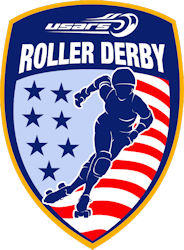 After three years with a horse in the race, we’re arriving at a point in time where USARS needs to start establishing itself as a legitimate and viable governing body for roller derby. If the greater roller derby community is to take the efforts of USARS seriously, it needs to start showing measurable progress towards the goals it has openly set for itself.
After three years with a horse in the race, we’re arriving at a point in time where USARS needs to start establishing itself as a legitimate and viable governing body for roller derby. If the greater roller derby community is to take the efforts of USARS seriously, it needs to start showing measurable progress towards the goals it has openly set for itself.
Primarily, this would entail the first real steps toward meaningful sanctioned international competition, through their parent organizations at the U.S. Olympic Committee (USOC) and the Federation of International Rollersports (FIRS). Eventually, some years or decades away, this may include events like the Olympic games.
As things have worked out in the present, USARS is having some trouble rousing up participants for its domestic tournaments. The national roller derby championship was the only USARS tournament to take place in 2014, after the planned three regional qualifying events were canceled. Before that happened, a regional venue had to be quickly moved from Texas to Chicago, though no specific reason why was given.1
The quality of play at the tournament was a direct reflection of these issues. Of the 14 games played, nine of them ended in 80+ point blowouts with very little competitive value to show for. Two very good co-ed games on Sunday helped, but even a few of the closer games had some speed-skating pack play that made the derby very difficult to watch.2
The official line given by USARS for having to axe its play-in tournaments came down the lack of funding available from teams interested in participating, specifically those who would have had to fund two trips, one to regionals and a second to nationals.
Normally, USARS teams that advance out of the qualification tournaments earn prize moneys to help fund their trek to nationals. (If teams elect not to go, they forfeit their winnings.) The current system only works best with a high level of participation at the regional tournaments. This builds up a large prize pool, large enough to make nationals participation for the winning teams a much more realistic proposition, and one where investing in regionals participation makes sense for teams in the first place.
The prospect of a low regionals turnout makes it less likely that a team capable of playing on the national level will want to participate to begin with. (Tulsa Roller Derby, last year’s nationals host and a top-five USARS club, did not send a team to nationals this year.) When teams don’t show interest, a low regionals turnout actually happens. The perception of reality becomes reality, and I have to wonder if that may have been a factor this year.
There is no getting away from the fact that USARS tournament participation has been down each year the competition has been held. The first year had 16 teams in four regionals; last year had 15 teams in three regionals. This year, only 8 in zero regionals. Of those that played this past weekend, only two traveled a significant distance to do so. The hoped-for co-ed championship side tournament planned for this year didn’t materialize either.
The low tournament turnout is in spite of good inroads being made by USARS in pockets of the country. The northwest, the midwest, and the mid-south have multiple leagues and club teams that play by USARS rules primarily or on the side. Many of these teams are absolutely chomping at the bit to engage in interleague USARS play, and perhaps the regional tournaments would have been well-attended had they gone on.
However, if teams capable of going to nationals can only afford to go to regionals because there is no promise of financial incentives in advancing, you run the risk of a national tournament with very few teams, one that’s not worth putting on in the first place. This is one of many catch-22’s that USARS needs to start showing progress toward breaking out of and finding answers on how to do so.
USARS is making headway on its first chicken-and-egg problem, that of seeding the USARS rule set. A team wouldn’t consider adopting them unless there were nearby USARS teams to play against; without nearby USARS teams to play against, there would be no reason to adopt them. Either way, most would see no compelling reason to switch from WFTDA play, the entrenched roller derby standard.
In this respect, USARS has an ace in the hole: An overwhelming majority of people who have tried USARS derby absolutely love it.
All it takes is one or two players or leagues to give it try, and then to try it again…and before you know it, an established league is playing USARS games exclusively, or on occasion with WFTDA rules.3 It also gives local mash-up/club teams, like the PA All-Stars, a fun opportunity to get some more serious skating in. This idea is already starting to leak across borders, with teams in Mexico, South America, and the UK already giving them a go.

The lack of teams in their tournaments does not look well on USARS, but the fact that people are talking about its style of play more, for better or worse, can only help its cause. Whether or not these people have an immediate interest or the means to try USARS derby at this stage is less important than them being aware that the USARS option is out there.
If at some point in the future, these same people have an opportunity to play in a USARS game or scrimmage, USARS is betting that, through positive skater word-of-mouth, they won’t turn it down.
Here is where USARS needs to get going the most if it hopes to take real, positive steps as a national governing body. As we have seen with the WFTDA, how good the product is is less important than how well it is marketed.4 A superior on-track product—which USARS believes it has—can be perceived as inferior if it is not properly framed as such.
No matter how good its rule set may be, if USARS continues hosting showcase tournaments among teams ranked 16th, 20th, 154th, 310th, 313th, 421st, and 552nd in the country, no amount of rules or skater improvement will make up for the blowouts resulting from the astronomical skill differences of teams playing each other.
On the other hand, that’s not an issue for one of roller derby’s biggest events, the Roller Derby World Cup. (Blood & Thunder will be hosting the second-annual women’s version of event in Dallas later this year.) No one from within the community bats an eyelash at the large skill gap between competing nations, but at this point that’s to be expected—a lot of countries are still learning the game.
The national skating federations of those countries are also learning about how to locally govern the game, too. Here is where USARS has yet another ace in the hole. Or at least, a king.
Though only having governing authority in the United States, USARS has some influence with FIRS, its international parent. As one of the largest members of FIRS, it can make things happen that NGBs from other countries may not be able to. For example, it was USARS representatives that in 2011 successful lobbied FIRS to recognize roller derby as an official (for FIRS) international rollersports discipline, enabling USARS to divert resources for derby.
Naturally, there are many countries with ties to FIRS, including those that have nationally adopted WFTDA rules. However, the USARS-FIRS connection is the most interesting, considering what FIRS is planning on doing in the near future in the hopes of raising the profile of rollersports as a potential addition the Olympic Games.
The 2017 Roller Games5/FIRS World Championships will be the first of an every-four-years showcase, unifying the international championships of dozens of rollersport disciplines into a single, X-Games/Olympic-like two week event. Roller derby will be one of featured sports.
One problem: FIRS does not yet have an internationally ratified roller derby rule set. While WFTDA rules are recognized by players as an international standard and will be in use at the (non-sanctioned) World Cup, it is not yet recognized by FIRS and the 120+ countries it represents. Since the WFTDA has positioned itself as an international competitor in the rollersports space, there’s a real chance that FIRS may rebuff that and adopt its own roller derby rule set—potentially the one currently incubating in the United States.
If the USARS rule set becomes the FIRS rule set and gets seeded to all of those countries, thereby giving international skaters the option to play roller derby in a completely new and fun way, they’re going to give it a try. A fair number of them are probably going to like it, if reaction in the States is any indication.
If that happens, things will get interesting, mighty quickly.6
As such, USARS Roller Derby is working double-time to make sure its rule set is working well enough to be presentable for international competition. In addition, USARS will want to demonstrate to the international rollersports federation that it has a regional structure that can work, to potentially be offered as a template to other countries looking to set up shop locally.
That is important, because regional derby governance in other countries, for the most part, sucks.
RDAC fizzled out in Canada, UKRDA is having issues w/Team England, USARS has its own challenges. Is regional derby governance a lost cause?
— RollerDerbyNotes.com (@derbynotes) October 2, 2014
USA Roller Sports is part of that conversation, too. However, it is one of the few, if not the only regional governing body in a position to potentially do something about it.
If people operating the roller derby arm of USARS can overcome the issues still plaguing the rest of the body and demonstrate to the world that top-down, regionally governed derby can co-exist with the multinational grassroots governance of the WFTDA, that may get more countries, and FIRS itself, on board with the USARS way of doing the derby thing.
But none of the above will really matter if it can’t turn things around at home and get more teams playing in its tournaments. That’s job one for USARS over the next two years, and especially next year, which may be make-or-break time for it.
If it’s still having trouble getting teams to come to its tournaments, perhaps a restructured regional playoff will help. Whatever happens, the only acceptable result for USARS in 2015 would be a significant increase in interest and participation from current and new USARS teams. Another year like 2014 would be a disaster, maybe one that can’t be realistically recovered from.
If USARS Roller Derby can cure what’s ailing it, however, it is in a position to potentially help bring roller derby to a new level. If it can win the confidence of FIRS, it will expose the world to a different way of playing derby. This can only make the game better for everyone.
As is always the case with USARS, that’s a big “if.” To meet its goals and prove its critics wrong, it needs to get going. Right now.
